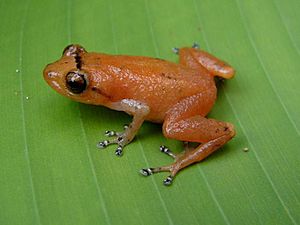Esmeraldas robber frog facts for kids
Quick facts for kids Esmeraldas robber frog |
|
|---|---|
 |
|
| Conservation status | |
| Scientific classification | |
| Synonyms | |
|
Hylodes gularis Boulenger, 1898 |
The Esmeraldas robber frog, also known as Diasporus gularis, is a small frog. It belongs to a family of frogs called Eleutherodactylidae. You can find this frog in parts of western Colombia and northwestern and central Ecuador. It's a very common and adaptable species!
What Does It Look Like?
Adult male Esmeraldas robber frogs are about 17 to 22 millimeters (0.7 to 0.9 inches) long. Adult females are a bit bigger. They measure around 21 to 25 millimeters (0.8 to 1.0 inches) from their nose to their bottom.
The frog's head is as wide as its body. Its snout, or nose area, is long. It looks pointed from above but flat from the side. The frog has an eardrum (tympanum) that is partly hidden by a small fold of skin.
Its fingers have small, flat tips. The toes have tips that are shaped like spearheads. The toes also have small webs at their base.
The skin on the frog's back is usually smooth. Some frogs might have small bumps. The back is yellowish-tan, and its sides are yellow. It has some reddish-brown marks on its back. These include a bar between its eyes and stripes near its eyes. There are also smaller marks on its shoulders and legs. The part of its eye that gives it color, called the iris, is golden bronze. It has a reddish-brown line across it.
Male Frog Calls
Male Esmeraldas robber frogs make a special sound to attract females. This sound is a "whistle." It's a single, clear note that lasts about 0.11 seconds. They whistle about five times every minute. This whistle has a main sound frequency of 2.7 to 3.0 kHz.
Where It Lives and How It's Protected
The Esmeraldas robber frog is a very common frog. It lives in both natural forests and places where the land has been changed. This includes areas where trees have been cut down (deforested areas). You can find it at elevations up to 1,770 meters (5,810 feet) above sea level. However, it is most often found below 400 meters (1,300 feet).
This frog is much more common in areas with new, growing plants or changed land. It is less common in old, untouched forests. This species can adapt to many different places. It also lives in many protected areas. Because of this, the Esmeraldas robber frog is not currently facing any major threats.
See also
 In Spanish: Diasporus gularis para niños
In Spanish: Diasporus gularis para niños


